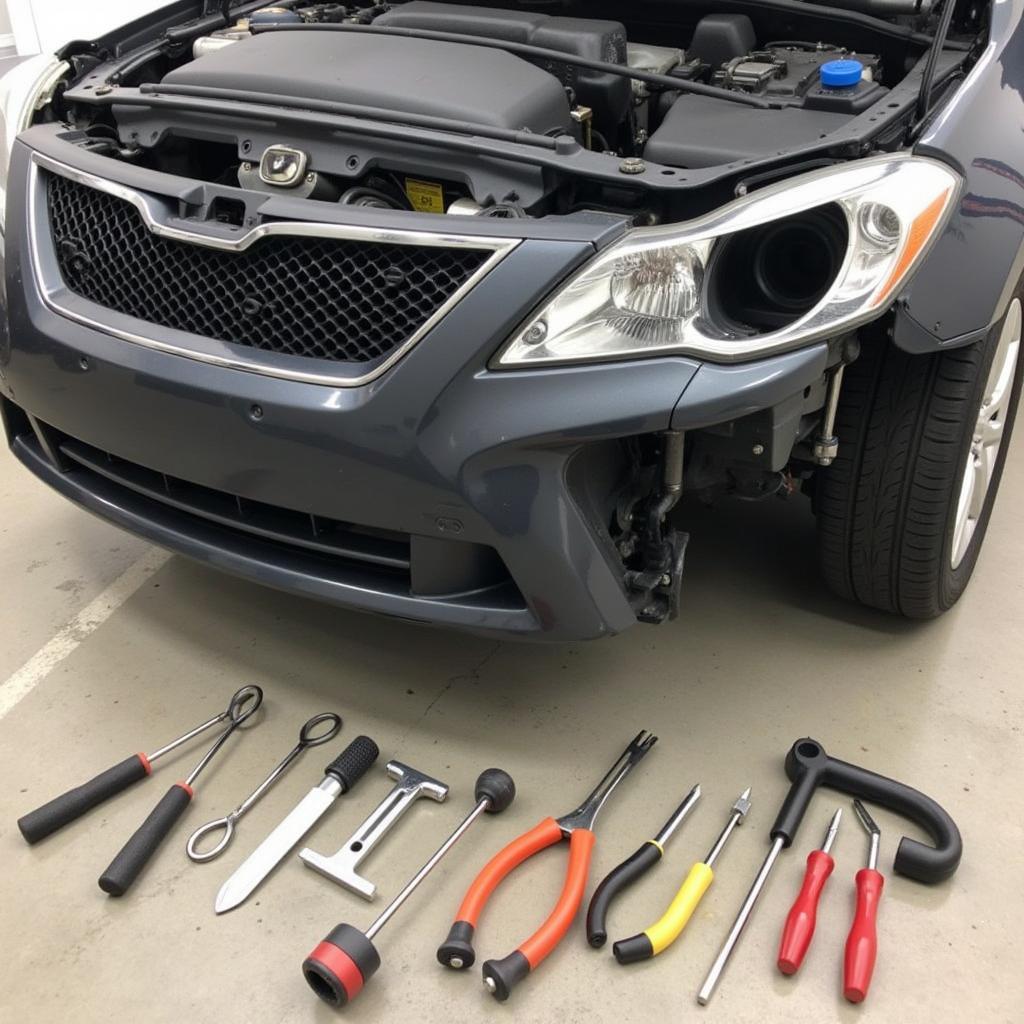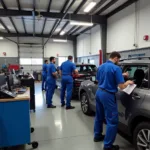Understanding the correct car body repair order of work is crucial for a high-quality, lasting repair. Whether you’re a DIY enthusiast or a professional, following the proper sequence ensures efficiency and prevents costly rework. This guide will walk you through the essential steps involved in car body repair, from initial assessment to the final polish.
Initial Assessment and Damage Analysis
Before any hands-on work begins, a thorough assessment of the damage is paramount. This involves identifying the extent of the damage, including hidden damage that might not be immediately visible. Documenting everything with photos and detailed notes is vital for insurance claims and accurate repair planning. This stage also involves determining the necessary tools, materials, and techniques for the specific repair. Failing to properly assess the damage can lead to inadequate repairs and future problems.
Parts Removal and Disassembly
Once the damage is fully understood, the next step is to remove any damaged parts and disassemble the necessary areas. This might involve removing panels, bumpers, lights, or interior components. Proper disassembly techniques are crucial to prevent further damage and ensure efficient reassembly. Labeling and organizing removed parts is highly recommended for a smooth and organized repair process.
Why Disassembly is Important
Disassembly allows access to hidden damage and ensures a complete repair. Think of it like surgery – you need to expose the affected area before you can fix it properly.
 Car Body Disassembly Process
Car Body Disassembly Process
Repairing the Underlying Structure
With the damaged area exposed, the focus shifts to repairing the underlying structure. This often involves straightening bent metal, welding damaged sections, and replacing corroded parts. The structural integrity of the vehicle is paramount for safety and handling, so this stage requires precision and expertise.
Straightening Techniques
Various techniques are employed to straighten bent metal, including using specialized tools like frame machines and hydraulic pullers. The goal is to restore the vehicle’s original frame dimensions.
Body Filler Application and Shaping
After the structural repairs are complete, body filler is applied to smooth out any imperfections and prepare the surface for painting. This involves carefully applying and shaping the filler to match the original contours of the vehicle. Proper sanding and feathering techniques are essential for achieving a seamless finish.
Priming and Sealing
Once the body filler is cured and sanded smooth, the next step is applying primer and sealer. Primer provides a uniform base for the paint to adhere to, while sealer protects the underlying metal from corrosion and provides additional adhesion for the paint.
The Importance of Priming
Primer acts as a bridge between the body filler and the paint, ensuring proper adhesion and a durable finish.
Painting and Clear Coat Application
After the primer and sealer have dried, the base coat color is applied, followed by a clear coat for protection and shine. This stage requires careful attention to detail and a dust-free environment to achieve a flawless finish.
Reassembly and Final Adjustments
Once the paint has fully cured, the reassembly process begins. All removed parts are carefully reinstalled, ensuring proper alignment and fit. Final adjustments are made to ensure everything functions correctly.
Polishing and Detailing
The final step involves polishing and detailing the repaired area to blend it seamlessly with the rest of the vehicle. This enhances the overall appearance and restores the vehicle’s shine.
Conclusion
Mastering the car body repair order of work is essential for achieving professional-quality results. By following the proper sequence and employing the correct techniques, you can ensure a lasting and visually appealing repair. Remember, a thorough understanding of the car body repair order of work is key to a successful restoration.
FAQ
- How long does a typical car body repair take? The repair time depends on the extent of the damage, but it can range from a few days to several weeks.
- Can I do car body repair myself? While some minor repairs can be done at home, complex repairs are best left to professionals.
- How much does car body repair cost? The cost varies depending on the extent of the damage and the labor rates in your area.
- What type of paint should I use for car body repair? Automotive paint specifically designed for car body repair is recommended.
- How do I choose a reputable car body repair shop? Look for shops with certified technicians, positive reviews, and a warranty on their work.
- What is the most important step in car body repair? A thorough initial assessment is arguably the most crucial step, as it sets the foundation for the entire repair process.
- How do I prevent rust after car body repair? Proper surface preparation, priming, and sealing are crucial for preventing rust.
Need assistance with your car repair? Contact us via WhatsApp: +1(641)206-8880, or Email: [email protected]. Our 24/7 customer support team is ready to help.

